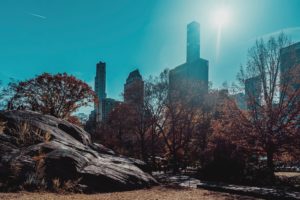You have no items in your cart. Want to get some nice things?
Go shopping
Back when I was a would-be punk rocker (more Blondie than Bad Brains), there were two ways to escape Brooklyn’s brutal summers: Take the D train south to Brighton Beach or north to Central Park.
Brighton beach had the boardwalks and sea air – not to mention Coney Island, its raucous sister down the road, with its Cyclone roller coaster and Nathan’s hot dogs (best consumed in that order). But it was the early ‘80s and if you wanted to be cool, you went to Manhattan.
At night, we’d sneak out to dance at CBGBs in the Bowery or the Mudd Club in TriBeCa. If we had extra cash, we’d scour thrift stores in the Village for leather jackets with silver zippers, pink jump suits with silver zippers, really anything with silver zippers. But if we wanted something bigger, something that would deliver us from the city, we’d take the subway uptown to Central Park. After an hour underground, we’d burst on to the street, sweating but energized. We’d fly through the park on our skates, crouch under stone bridges to smoke weed, scramble up the rocks to spy on couples making it in the grass.
It wasn’t as if we were returning to our natural habitat. That was the bagel shop on Avenue M or the cramped apartments of Ocean Parkway. To go to Central Park was to see our fellow New Yorkers out of place. We were not our regular selves and yet we sensed the possibility. If there was a war between the city’s skyscrapers and the park’s sycamores, we knew the city would win, crushing the park beneath its concrete feet. But if that fight was not physical, but spiritual, the kind that tells you that maybe there is a better way, not screaming and smoking and pushing, but air in your lungs, sun in your eyes, space in your head, Central Park would be the victor.
No matter how much energy we had, the park always settled us. By a lake, by a rock, by a tree, we’d finally relax. We’d talk for hours, until it was time to go home, never quite ready to face the roar of the subway or the confines of our apartments and houses.
But the park was more than Zen retreat. It was a place where BIG things happened. It’s where I saw my first outdoor concert – Elton John singing “Imagine,” a tribute to his friend, John Lennon, who would die three months later outside the Dakota apartments overlooking Central Park. It’s where I attended my first rally, marching from the United Nations to the Great Lawn, chanting for nuclear disarmament with 600,000 other people, carrying my “Bread, Not Bombs” sign and the tuna fish sandwich my mother packed for me. Coretta Scott King told us: “We have come here in numbers so large that the message must get through to the White House and Capitol Hill.” We were young enough to believe her, intoxicated by the power of “acres of people.”
At times, we suffocated the park with our marches and free concerts, hundreds of thousands of people crushing every blade of grass, bending every tree limb until they could no longer bounce back. The park would grow angry and lash out, taking our friends, one by one. I don’t think I ever went to a concert without losing someone to a porta potty or snack cart. Ivy or Joel or Carolyn would leave our blanket for something to eat or to go to the bathroom and never return (“I got lost, man,” we’d hear later, back in Brooklyn, and we knew it was true because it had happened to us too). At Simon and Garfunkel’s 1981 free concert, I nearly suffocated as I weaved my way to the porta potties, the crowd lifting me off my feet, squeezing me until I could barely breathe. I tried to move my arms and legs, but they were no longer mine, caught in the crush of bodies. Then, just as quickly, I found my footing and ran, terrified, to the subway, all the way back home to Brooklyn, never even hearing “Bridge Over Troubled Water.”
The park, with its prissy paddle boats and vintage carousels, wasn’t perfect. I once left a Ramones concert on venue objections alone. No punk band should ever perform on an ice-skating rink turned concert venue at 6:30 p.m. on a bright summer evening. The Ramones were for night clubs with sticky floors and big amps.
Even if the Ramones had played at 11 at night in the park, I doubt I would have gone. Like most New Yorkers, I was much more at home in the Quaalude-infested bathroom of CBGBs than I was in Central Park after dark. I wasn’t afraid of muggers or rapists, but of the nature itself, everything alive, hiding in the darkness. It was a discomfort I’d carry with me my whole life, even after moving to Alaska (especially after moving to Alaska). On my first day in Anchorage, when I saw a grizzly lumbering toward our car, I told my boyfriend, “Don’t make eye contact,” not even allowing myself a second look at the wonderous creature. Schooled on the subways of New York, where avoiding eye contact was the best way to keep letches and losers at bay, it was the only way I knew how to protect myself. I later learned animals do the same when trying not to provoke a predator.
The one time I entered the park at night was for a boy. His name was Andy. He played drums in a garage band. He carved replicas of the black obelisk on the cover of Led Zeppelin’s Presence album. His hair was blonde, and his jeans were torn. I was desperate to impress him. Earlier in the evening, he’d taken me to my first Japanese restaurant in Greenwich Village. I was 15, intimidated (the only non-American food I’d eaten was pizza) and starving. I tried to copy his moves but couldn’t figure out the chopsticks. The minute he left for the bathroom, I tipped the bowl of noodles into my mouth, slurping up as much as I could. He caught me on the way back to the table, our eyes meeting in shame. When he asked if I wanted to hang out in Central Park, I agreed. How else could I redeem myself – the girl with noodles on her chin who didn’t know how to use chopsticks? We grabbed the train uptown but got off at the wrong spot. The only way into the park was over a concrete wall with a five-foot drop into the darkness. Rather than slowly climb down, I jumped, spraining my ankle so badly I couldn’t dance for months. We never made it to the bench; I barely made it home.
For me, the park was at its best in the day, concert-less, protest-less, mine. There, I could forget about the boys I liked who didn’t like me, my strict father, my growing awareness of the world’s injustices and my adolescent impotence. As long as I was inside the park, I felt safe.
But like the shock of bright sun after a matinee, the world outside the park could be harsh. Surrounded by some of New York’s most expensive real estate, its sidewalks were full of women in couture suits with houses in the Hamptons, a place we didn’t even know existed. They were the “one percent” back when we just called them millionaires. In my purple pleather pants and Clash t-shirts, I knew I didn’t belong. They could look down at me from their high rises all they wanted when I was inside the park, but on the street, so close to them, I felt truly small. Even the doormen, with their white gloves and golden epaulettes, sneered, though they probably lived down the street from us in Brooklyn. It wasn’t until I was on the subway, the familiar smell of urine and hot metal mixing in the air, that I felt comfortable again. By the time I got off the train at Avenue J and walked home, past the pizza place and the bagel store, past the orthodox Jewish girls in their long sleeves and high-neck dresses, past the apartments with their smell of fried onions, the park was gone.

Eve Rose
Eve Rose is an award-winning journalist who has covered everything from the U.S. Congress to the Iditarod. Eve studied creative writing at NYU and the Vermont College of Fine Arts. Her work has been published by Pure Slush (Australia), Litro, among others.




